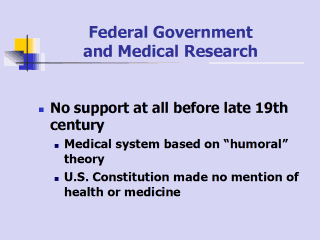 |
Support of medical
research by the U.S. federal budget enjoys widespread public support today.
Few people realize that the Federal government provided no funding at all
for this activity before the later nineteenth century. The principal reason
for this is that health and disease were understood differently from the way
they are today. The body was viewed as composed of four "humors," or fluids:
blood, phlegm, yellow bile, and black bile, each of which had well-known
properties. When these humors became unbalanced, disease ensued, and adding
or removing a particular humor was viewed as the best way to cure the
patient. Bloodletting is perhaps the best known example of such medical
intervention. The framers of the U.S. constitution, who shared this medical
world-view, made no mention of health or medicine in that document beyond a
reference to the government’s responsibility "to promote the general
welfare." |
